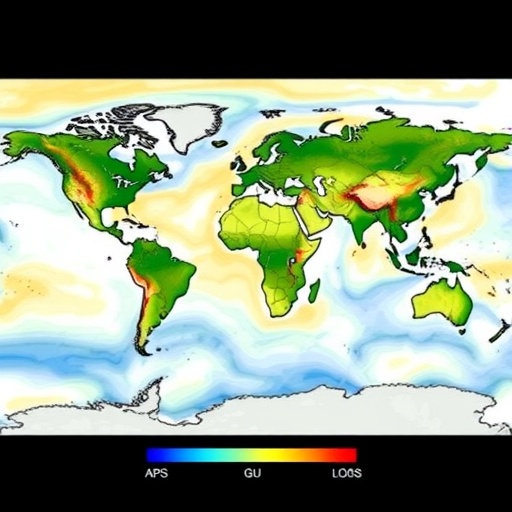A groundbreaking study has unveiled an unexpected and crucial factor influencing global vegetation productivity: terrestrial surface wind speed changes. As climate scientists grapple with understanding the complex interactions between the atmosphere and the biosphere, this newly published research highlights that shifts in wind dynamics can substantially alter plant growth and ecosystem productivity worldwide. Such insights may redefine how we model carbon cycling and predict ecological responses to climate change, offering fresh perspectives on how Earth’s ecosystems could evolve in coming decades.
Vegetation productivity, often measured as gross primary production (GPP), represents the amount of carbon dioxide plants assimilate through photosynthesis. Traditionally, factors such as temperature, precipitation, soil moisture, and atmospheric CO2 concentration have dominated discussions surrounding global vegetation changes. However, the role of wind speed—a key physical driver that modulates evaporation, gas exchange, and microclimate around plants—has largely been underappreciated. The study, authored by Wu, Fu, Zhang, and colleagues, bridges this gap by analyzing how surface wind speed variations impact vegetation productivity at a global scale using an intricate combination of satellite observations, field data, and process-based ecosystem modeling.
The researchers began by quantifying long-term trends and spatial patterns in terrestrial surface wind speeds using reanalysis datasets spanning multiple decades. They identified significant changes in wind speeds across various biomes, including noticeable declines in some regions and increases in others. These variations do not occur in isolation; they are intertwined with alterations in temperature, humidity, and soil moisture, all of which affect plant physiology. Through comprehensive sensitivity experiments using an advanced land surface model that integrates dynamic vegetation processes and atmospheric feedbacks, the team isolated the direct and indirect effects of wind on photosynthesis and transpiration at the global scale.
One key mechanism highlighted by their work involves the modulation of leaf boundary layer conductance by wind. Wind influences the thickness of this layer—a microscopic zone of still air enveloping leaves—which directly affects the exchange rates of CO2 and water vapor between the leaf surface and the atmosphere. When wind speeds increase, the boundary layer becomes thinner, facilitating more efficient gas exchange. This leads to enhanced CO2 uptake, boosting photosynthetic rates and thus vegetation productivity, assuming other factors remain favorable. Conversely, reduced wind speeds can result in thicker boundary layers, limiting gas exchange, and constraining photosynthetic performance.
Moreover, surface wind speed impacts evapotranspiration rates, which in turn influence soil moisture availability. Enhanced wind promotes greater water loss from vegetation and soil, potentially stressing plants in arid and semi-arid regions. The study demonstrates this effect by showing how vegetation productivity can decline in areas where increased winds exacerbate drought conditions. In contrast, in humid regions with ample precipitation, elevated wind speeds tend to improve microclimatic conditions by reducing leaf temperature through increased convective cooling, thereby supporting higher productivity. This dualistic role of wind illustrates why its influence varies geographically and emphasizes the complexity underlying vegetation responses to climatic drivers.
In addition to physical processes, wind-driven dust and aerosol transport, which can affect photosynthetically active radiation (PAR) reaching plant canopies, were considered to assess indirect influences on vegetation growth. The research identifies how variations in wind patterns alter aerosol deposition, affecting light interception by leaves and consequently photosynthesis. This interplay adds another layer of intricacy to the multifaceted effects of wind on terrestrial ecosystems, underscoring the need for integrated model frameworks that encapsulate such interactions.
By employing multi-model ensemble simulations and observational constraints, the study rigorously validates the sensitivity of global vegetation productivity to wind speed changes. Results indicate that accounting for wind-related processes significantly improves the accuracy of carbon flux predictions compared to models that neglect these dynamics. This advancement holds critical implications for Earth system models used in climate projections, as enhanced predictive capability can inform better management and conservation strategies.
Importantly, this research sheds light on feedback loops within the climate-vegetation system. For instance, shifts in vegetation productivity driven by wind changes can alter atmospheric CO2 concentrations, subsequently influencing climate patterns, including wind regimes themselves. Such feedbacks emphasize the interconnectedness and nonlinearity of Earth’s climate system, necessitating holistic approaches in future studies.
The study also explores potential future trajectories under climate change scenarios, predicting varied regional responses based on projected wind speed alterations. Some areas may experience amplified vegetation growth, contributing to carbon sequestration, while others could face declines, possibly accelerating ecosystem degradation and carbon release. These spatial disparities call for targeted monitoring and region-specific adaptation strategies to mitigate adverse impacts on biodiversity and ecosystem services.
In sum, the revealing link between terrestrial surface wind speed and vegetation productivity invites a paradigm shift in ecosystem science and climate research. It highlights an often-overlooked meteorological variable that exerts profound influences on global plant functioning and the carbon cycle. As the world intensifies efforts to combat climate change, incorporating wind dynamics into ecological models presents a promising avenue to refine predictions, optimize interventions, and enhance resilience of natural systems.
Future research prompted by these findings could delve deeper into species-specific responses to wind changes, unraveling how community composition and ecosystem structure adapt. Additionally, coupling vegetation models with atmospheric chemistry and aerosol dynamics may unravel further complexities. Field experiments designed to manipulate wind conditions could validate and refine mechanistic understanding, bridging observational gaps.
Ultimately, this study by Wu et al. exemplifies the power of interdisciplinary research that blends atmospheric science, ecology, and modeling to uncover subtle yet significant drivers of Earth’s biosphere functioning. It not only enriches fundamental knowledge but also equips policymakers and stakeholders with novel insights to safeguard global ecosystems amid an era of rapid environmental change.
Subject of Research: Terrestrial surface wind speed changes and their impact on global vegetation productivity.
Article Title: Significant sensitivity of global vegetation productivity to terrestrial surface wind speed changes.
Article References:
Wu, H., Fu, C., Zhang, L. et al. Significant sensitivity of global vegetation productivity to terrestrial surface wind speed changes. Nat Commun 16, 9315 (2025). https://doi.org/10.1038/s41467-025-65000-x
Image Credits: AI Generated




